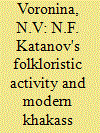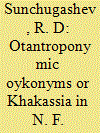|
|
|
Sort Order |
|
|
|
Items / Page
|
|
|
|
|
|
|
| Srl | Item |
| 1 |
ID:
128485


|
|
|
|
|
| Publication |
2013.
|
| Summary/Abstract |
N.F. Katanov's difficult, arduous folkloristic collection is of special value in literary studies and cognitive aspects in his extensive scienti?c, pedagogic, enlightening and social activity. Recorded and processed by an outstanding Khakass scholar, folklore texts are not only keepers and translators of the Turkic peoples' spiritual culture but they also accumulate creative work of Khakass poets and novelists. For example V. K. Tatarova (1952), a Khakass poet and novelist, distinguished public figure and famous theorist of Katanov studies wrote parables/ book of poems Cowberry on a palm in 1995 on the basis of materials of an ethnographic expedition around the Minusinsk depression carried out by N. F. Katanov in 1889-1892. It should be noted that "... in the sphere of the Turkic-speaking habitation of Siberia and Eastern Turkestan a researcher managed to collect a great linguistic, ethnographic and folklore material" which today is of
cognitive value as a collection of Turkic fairytales, fables, songs, proverbs and sayings. "Folklore materials were published in the IX volume of Folk literature samples of the Turkic tribes (St. Petersburgh, 1907) where folklore pieces of work of the Uryankhais (1,410 names), Khakasses (1,159 names), Karagases (203 names) were included"?
|
|
|
|
|
|
|
|
|
|
|
|
|
|
|
|
| 2 |
ID:
128487


|
|
|
|
|
| Publication |
2013.
|
| Summary/Abstract |
In recent years in linguistics, investigation of proper names including anthroponymics and oykonymics has been developing extensively. Anthroponymics is a branch of onomastics, which studies anthroponyms
-personal names of people: proper names, patronymics (father's names or other names after father), surnames, tribal names, nicknames and pseudonyms (individual or group), cryptonyms (concealing names)';
oykonymics is a branch of toponymy, which studies oykonymsz, i.e. names of any settlements. These branches are still one of the poorly studied ?eld of Turkic onomastics. In Khakass toponymy considerable part of settlements' names belong to anthroponyms, i.e. proper names and surnames. Formed from anthroponyms, oykonyms give important information of linguistic, historical, ethnographical and ethnocultural nature. They point at the bygone settlement of peoples and tribes, reflect traditional folk culture
and change processes in the socio-political and economic life of people.
|
|
|
|
|
|
|
|
|
|
|
|
|
|
|
|
| 3 |
ID:
128486


|
|
|
|
|
| Publication |
2013.
|
| Summary/Abstract |
The first information about the Khakass dialects and their phonetics is contained in pre-revolutionary sources, first of all in the works of M. A. Castren, V.V. Radloff, N. F. Katanov. In his work Versuch einer koibalischerz und karagassischerz Sprczchlehrel M. A. Castren described the Koybal dialect of the Khakass language; in the section Phonetics, he details the composition of vowels and consonants of the dialect. Next researcher in the phonetics of the Khakass dialects is V. V. Radloffz. It is for the first time in the history of Tu rcology, that he represented the entire classification of sound structure of the Turkic languages-'. I_ However, one of the most famous representatives of pre-October h Khakass studies is N. F. Katanov.
|
|
|
|
|
|
|
|
|
|
|
|
|
|
|
|
|
|
|
|
|